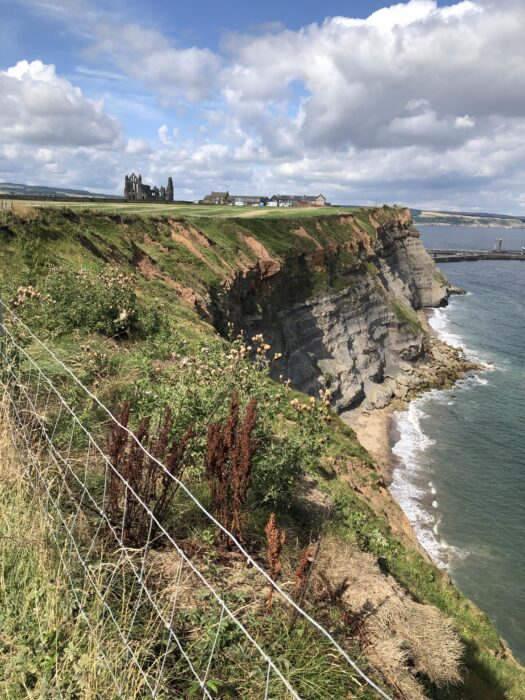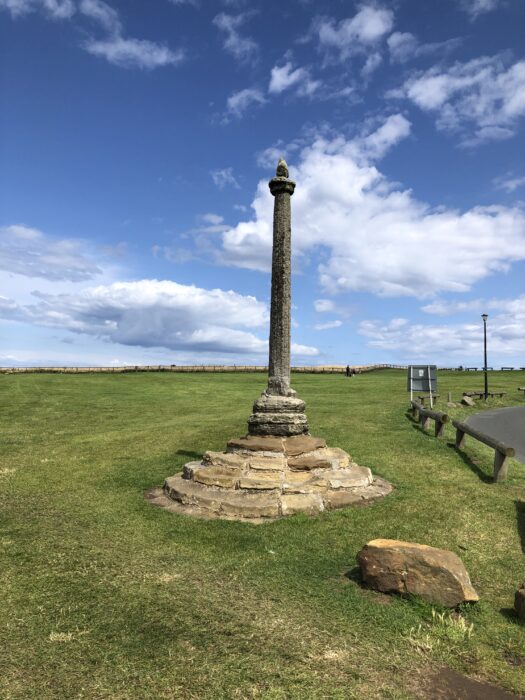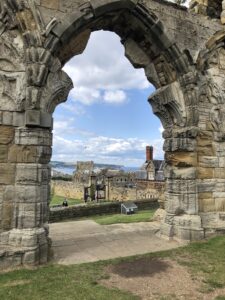
Writing is an exercise in imagination. And one of my favorite places to let my creativity run wild is Whitby, on the east coast of Yorkshire at the mouth of the River Esk.
This is a photo from the west entrance to the ruins of Whitby Abbey, a Benedictine monastery from the 12th century. With one important exception, the view encompasses layers of history.
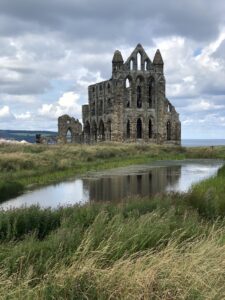
The monastery sits on the East Cliff. Next to it is Cholmley House, once the abbot’s residence. Looking further, the viewer sees St. Mary’s Church and graveyard, to the left of which are 199 steps down into the town.
In the distance there’s an expanse of sea and the West Cliff. Hovering over the scene are banks of white clouds which literally come and go with the wind.

The Benedictine Abbey captivated me the first time I saw it, as it does many visitors. But I’m far more interested in the original Anglo-Saxon abbey built in 657 in a place then called Streanaeshealh. What’s left of that abbey is a visually empty site.

A woman named Hild built the original monastery, not the medieval monument. Hild’s name is not known today as a princess, or an abbess (both of which she was), but as the abbess who hosted a church synod in 664. The event marked the dominance of the Roman church in England, an obscure decision from our perspective. Church historians, particularly Bede, remembered Hild because the synod took place at her monastery. Through the ages, Hild became one of the few recognized women.
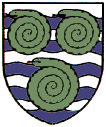
Legends surrounded Hild. It was said sea birds tipped their wings when flying over the monastery in tribute to the abbess. A more enduring story is about Hild and a plague of snakes. She ordered the serpants to leave or be turned into stone. Ammonite fossils are often found in the area. The snakestones were said to be the remains of snakes too slow to leave. The genus of this particular ammonite is Hildoceras. The Whitby Coat of Arms incorporates the snakestones, keeping the story alive.
When Hild established her monastery on the headland near the mouth of the Esk River, the topography was entirely different. The land might have extended 200 meters further out. But the cliff edge suffers erosion at a rate of 10 meters every 100 years, vastly changing the landscape.
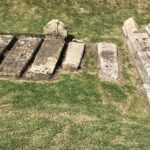
There’s an Anglo-Saxon plinth near the present parking lot, which might have been erected for an Anglo-Saxon marketplace. Anglo-Saxon graves near the present abbey ruins give some idea how large the Anglo-Saxon monastery might have been.
Viking raiders began attacking the Yorkshire coast in the mid-ninth century, and the Anglo-Saxon monastery faded into history. The invaders named the area Whitby, meaning “White Settlement” in Old Norse.

Benedictine monks began constructing a monastery on the site in the 12th century, and the Gothic structure presently visible was complete in the 13th century. After Henry VIII suppressed the monasteries, the Cholmley family purchased the land, dismantled most of the buildings to reuse their materials, and adapted the former abbot’s residence for their own use.
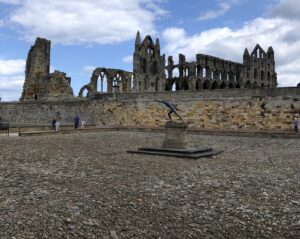
The house is fronted by a cobbled courtyard with a bronze statue in the center. In 1682, one observer described the house as ‘a most delicate and stately hall, supposed to be exceeded by few in England for the bigness of it, … the hall is of freestone, with large courts and walks with iron grates, and a curious statue in solid brass as large as life in the midst of the square, with a delicate bowling green, gardens, etc., which are extremely pleasant.’
The statue is a copy of a reproduction of a marble statue of gladiator that became part of Cardinel Borghese’s private collection during the 17th century. Charles I commissioned a French sculptor to visit Italy to cast bronze copies of various marble sculptures. One of these the Borghese gladiator, which the Cholmley family reproduced and installed at the center of the front courtyard, perhaps to curry favor with the king.
Over the years, much of the Chomley family wealth came from mining and refining alum, which was used to fix dyes in cloth.
Next week’s blog will highlight other historic moments in Whitby history, including Captain James Cook’s apprenticeship and Dracula by Bram Stoker.
⛪️⛪️⛪️
St. Hilda at Hartlepool by James Clark
Whitby Town Coat of Arms
“Whitby’s Borghese gladiator is a classical masterpiece.” Whitby Gazette. Nov,. 28, 2018

Sandra Wagner-Wright holds the doctoral degree in history and taught women’s and global history at the University of Hawai`i. Sandra travels for her research, most recently to Salem, Massachusetts, the setting of her new Salem Stories series. She also enjoys traveling for new experiences. Recent trips include Antarctica and a river cruise on the Rhine from Amsterdam to Basel.
Sandra particularly likes writing about strong women who make a difference. She lives in Hilo, Hawai`i with her family and writes a blog relating to history, travel, and the idiosyncrasies of life.

